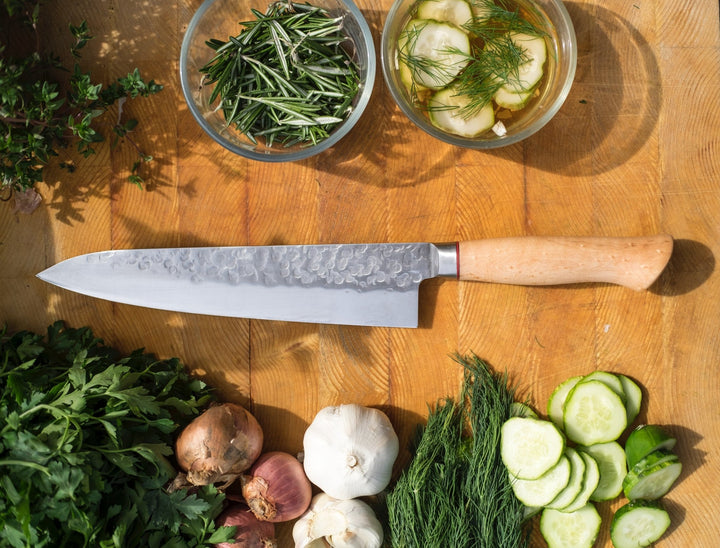As you step into a sushi restaurant and observe the skilled sushi chefs at work, you might notice an intriguing technique: they often hold the knife with one finger on top. This method is not just a quirk or personal preference but a deeply rooted technique in the art of sushi making. Understanding why sushi chefs hold the knife with one finger on top unveils a world of precision, tradition, and culinary expertise.

The Art of Sushi Making
Sushi making is an ancient Japanese culinary art that requires precision and a deep understanding of ingredients. The knife technique plays a significant role in ensuring the quality and presentation of sushi. Holding the knife with one finger on top is one of the techniques that exemplifies this precision.

Why This Technique?
The primary reason sushi chefs hold the knife with one finger on top is to maintain control over the blade. This technique allows for better manipulation, leading to more precise cuts. It also provides a balance that enhances the chef’s ability to make delicate slices, which is crucial in sushi preparation.
Improved Control and Precision
By placing one finger on top of the knife, chefs can exert just the right amount of pressure needed for slicing delicate items like fish. This control is essential in achieving the thin, uniform slices that are characteristic of high-quality sushi.
Tradition and Training
The technique of holding the knife with one finger on top is passed down through generations of sushi chefs. It is part of the rigorous training that sushi chefs undergo, often involving years of apprenticeship. This tradition is not only about mastering skills but also about respecting the art and its history.

Benefits of This Technique
Enhanced Safety
Holding the knife in this manner can also enhance safety in the kitchen. With better control over the blade, chefs are less likely to make erratic movements that could lead to accidents.
Consistency in Cuts
Consistency is key in sushi preparation. The uniformity of slices impacts the texture and presentation of sushi. This technique helps chefs achieve consistency, ensuring that each piece of sushi is perfect.

Comparing Knife Techniques
While the technique of holding the knife with one finger on top is prevalent among sushi chefs, it’s interesting to compare it with other culinary practices worldwide. For example, in Western culinary practices, chefs often use a pinch grip, holding the knife blade between the thumb and forefinger. This comparison highlights the uniqueness and specialization of sushi-making techniques.
Pinch Grip vs. Finger on Top
The pinch grip is favored for its ergonomic benefits, allowing chefs to use their whole hand for control. However, the one-finger-on-top technique used by sushi chefs is specifically tailored to the precision needed in sushi making.
Learning the Technique
If you’re a kitchen hobbyist eager to learn sushi-making techniques, mastering this knife grip is essential. Here are some steps to help you practice:
Step-by-Step Guide
- Choose the Right Knife: Use a sushi knife, such as the best Japanese chef knife, designed for delicate slicing.
- Practice the Grip: Hold the handle of the knife with your dominant hand. Place your index finger on top of the knife’s spine.
- Control the Pressure: Apply gentle pressure with your index finger. This will help you guide the blade smoothly.
- Practice Makes Perfect: Regular practice is key to mastering this technique. Start with simple items before moving on to slicing fish for sushi.
Importance of the Right Tools
Using the right tools is crucial for this technique. Sushi knives are specifically designed for the precision required in sushi preparation. Investing in a high-quality sushi knife can make a significant difference in your ability to execute this technique.
Choosing the Best Sushi Knife
When selecting a sushi knife, consider factors such as blade material, handle design, and overall balance. There are many options available, but it’s important to choose one that suits your skill level and needs.
Top Recommendations
- Yanagi Knife: Traditional Japanese knife ideal for sashimi.
- Deba Knife: Perfect for filleting fish.
- Usuba Knife: Great for vegetable preparation.
For more information on selecting the right knife, you can check the good chef cleaver knife.
Maintaining Your Sushi Knife
Proper maintenance of your sushi knife is essential to ensure its longevity and performance. Here are some tips:
Regular Sharpening
Regular sharpening keeps the blade in optimal condition. Use a whetstone for best results.
Cleaning and Storage
Clean your knife after each use, and store it in a dry place. Avoid the dishwasher as it can damage the blade.
For comprehensive knife care tips, visit the knife care tips guide.
Conclusion
Understanding why sushi chefs hold the knife with one finger on top provides a deeper appreciation for the skill and tradition involved in sushi making. This technique, rooted in precision and control, is a testament to the dedication and expertise of sushi chefs. Whether you’re a culinary professional or a home cook, mastering this technique can enhance your cooking skills and bring you closer to the art of sushi making.
FAQs
What is the primary benefit of holding the knife with one finger on top?
The primary benefit is improved control and precision, allowing sushi chefs to make delicate and accurate cuts.
Can I use this technique with any knife?
While it can be used with various knives, it’s most effective with specially designed sushi knives that are built for precision.
Is this technique difficult to learn?
With regular practice and the right tools, this technique can be mastered by anyone interested in sushi making.
As an Amazon Associate, I earn from qualifying purchases.
As an Amazon Associate, I earn from qualifying purchases.

